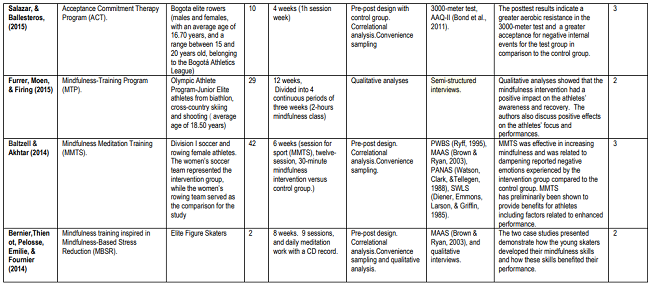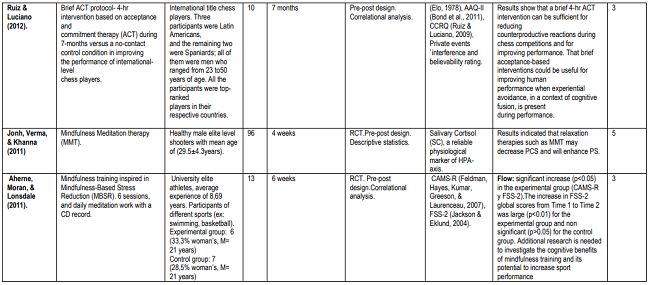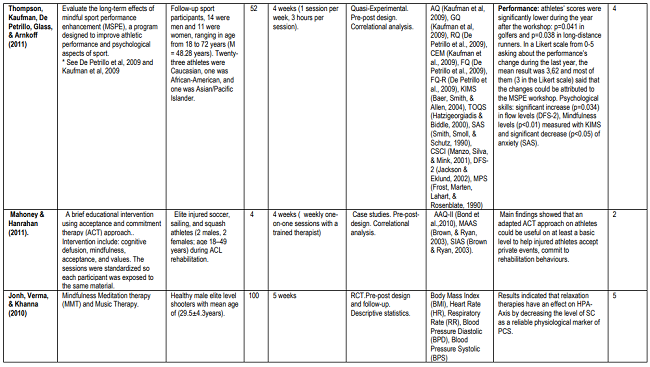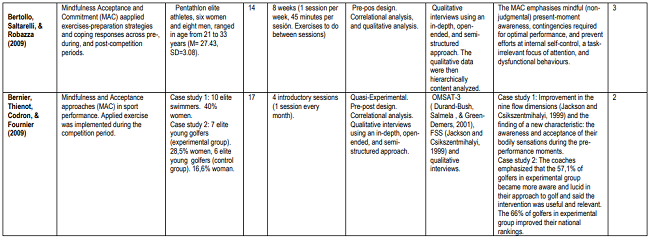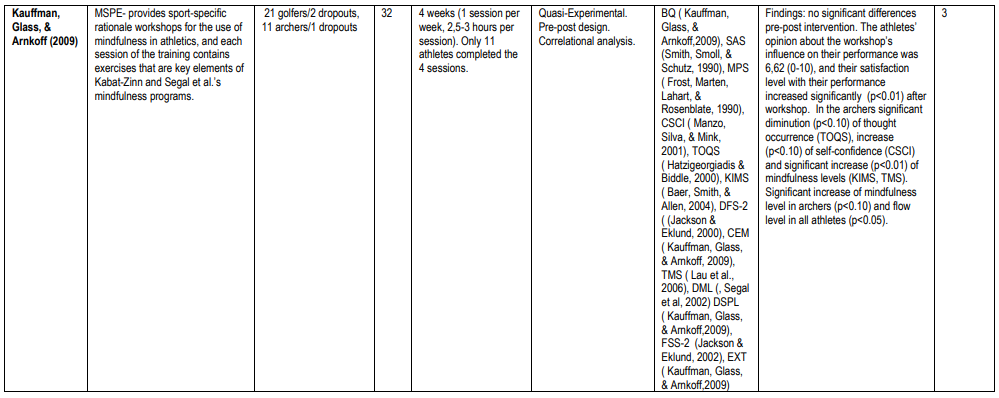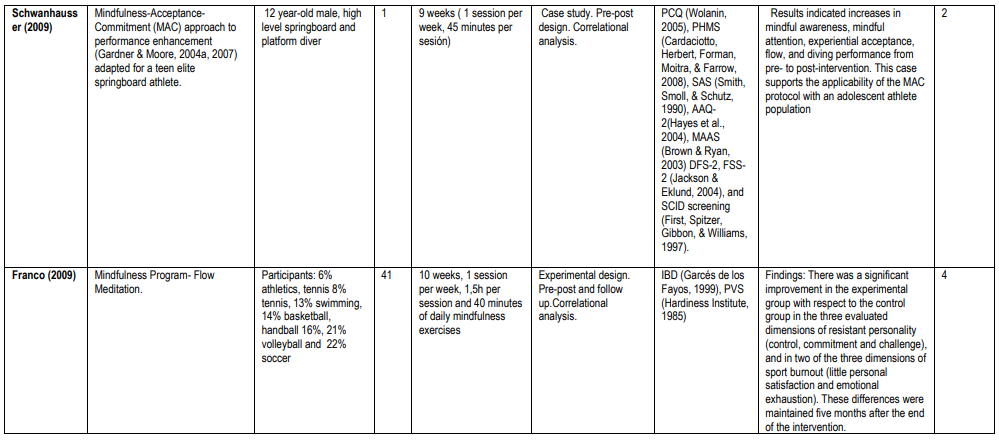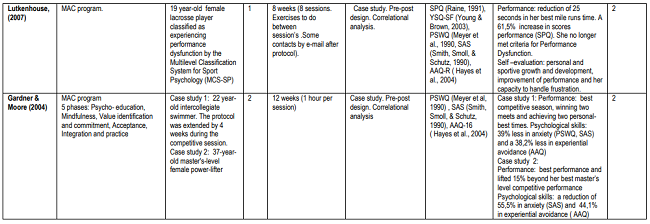Introduction
Sports performance can be thought of as a noun or verb. As a noun, sports performance describes an isolated event where the athlete presents the development of a specific set of knowledge, skills and abilities. As a verb, sports performance describes the process of developing an action plan for the implementation of psychological and physical skills during an event. Thus, the performance means using the knowledge, skills or abilities, not just possessing them (Serpa, 2002). Sport performance is a situation of self-evaluation and of evaluation by others, regulated and influenced by emotional and cognitive factors (Hook, Valentiner, & Connelly, 2013; Howle & Eklund, 2013).
Recently, mindfulness training has gained traction as a viable alternate approach to facilitate optimal performance (De Petrillo, Kaufman, Glass, & Arnkoff, 2009; Gardner & Moore, 2004, 2006, 2007, 2012; Gross, Moore, Gardner, Wolanin, Pess, & Marks, 2016; Thompson, Kaufman, De Petrillo, Glass, & Arnkoff, 2011). Mindfulness is thought to have two distinctive facets and definitions, namely 1) the self-regulation of attention in the present-moment and 2) the openness, willingness, and awareness of experiences in the present-moment (Bishop et al., 2004; Brown & Ryan, 2003; Kabat-Zinn, 2013; Siegel et al., 2010).
Mindfulness-based interventions have been used in various forms across clinical and health practice, including Mindfulness-Based Stress Reduction - MBSR (Kabat-Zinn, 2003, 2013), Mindfulness Based Cognitive Therapy - MBCT (Segal, Williams, & Teasdale, 2002; Teasdale, Segal, & Williams, 2003), Compassion Focused Therapy (Guilbert & Irons, 2005) and Acceptance Commitment Therapy - ACT (Hayes, Strosahl, & Wilson, 1999). In athletic contexts and more recent work, the fundamentals of these models have been integrated into Mindfulness Acceptance Commitment Program - MAC (Gardner & Moore, 2007, 2012, Gross, Moore, Gardner, Wolanin, Pess, & Marks, 2016), and Mindfulness Sport Performance Enhancement - MSPE (Kaufman, Glass, & Pineau, 2018; Kaufman, Glass, & Arnkoff, 2009, Thompson, Kaufman, De Petrillo, Glass, & Arnkoff, 2011). The theory behind and mindfulness-based programs concepts, which are taught in each of these models, are relatively consistent, the difference lying mainly in application. For example, the MAC approach draws on ACT, incorporating brief meditations, while also focusing on the nonjudgmental observation of the ongoing stream of internal and external stimuli, goal-directed behavior and values. In contrast, MSPE draws on the Mindfulness Based Stress Reduction program format and relies Tightly on different meditation practices, placing emphasis on somatic awareness and Hatha Yoga.
Hence, mindfulness-based interventions differ from the traditional implementation of psychological skills training in sport psychology, with the main skills including goal setting, arousal regulation, visualization, and self-talk. Such cognitive behavioral interventions are focused primarily on intentionally controlling one's thoughts, feelings and behaviors, and not regulate them as a mindset mode of being (Galluci, 2008; Gardner & Moore, 2004; Moore, 2009; Solé, Carraça, Serpa, & Palmi, 2014).
According to the models explaining sport performance (e.g., Birrer, Röthlin, & Morgan, 2012), there is a relationship between self-regulatory beliefs, such as self-efficacy, and mindfulness. Mindfulness is likely to prompt self-regulatory cognitions (Gardner & Moore, 2012). Crucial traits of mindfulness are nonjudgmental acceptance, openness to experiences and insight (Walach, Buchheld, Buttermuller, Kleinknecht, & Schmidt, 2006). Mindfulness contributes to both high levels of awareness and acceptance of in the moment reality (Kabat-Zinn, 1994, 2013; Kaufman et al., 2018; Solé, Carraça, Serpa, & Palmi, 2014). Aligned with the core tenant of mindfulness is the concept of acceptance, which can be conceptualized as “taking a stance of nonjudgmental awareness and actively embracing the experience of thoughts, feelings and bodily sensations as they occur” (Hayes, Strosahl, Bunting, Twohig, & Wilson, 2004). The hypothesized link between mindfulness and performance may refer to the altering perceptions of barriers and sense of control over oneself and the environment. Jon Kabat-Zinn et al. (1985) are the first on record to use mindfulness meditation training within sport. Rowers preparing for the Olympics independently practiced mindfulness training for two to seven weeks prior to the Olympic Games. Kabat-Zinn et al. (1985) reported that some of the U.S. Olympic team rowers who medaled reported the usefulness of mindfulness meditation in helping them optimize performance when racing. Sappington and Longshore (2015) in a similar review, examining mindfulness-based interventions with athletes, considers all approaches while focusing primarily on ACT. MAC and MSPE, as these were the most common methods noted in the literature. However, due to the relatively recent nature of these approaches in sport, there have also been a few studies applying a mindfulness-based intervention outside of these protocols (see Aherne Moran, & Lonsdale, 2011; Baltzell, Caraballo, Chipman, & Hayden, 2014).
The purpose of this literature review was to explore the potential benefit of mindfulness-based interventions for enhancing performance on elite athletes, and it does expand and reinforces the conclusions of Gardner and Moore (2012) and Sappington and Longshore (2015) reviews. Also, it consists an effort to more comprehensively evaluate the efficacy of mindfulness-based interventions and considers limitations in the present empirical evidence.
Methods
Utilizing a comprehensive search strategy, we conducted electronic searches of multiple electronic databases for randomized and nonrandomized control trials that evaluated mindfulness based interventions; that target populations of elite-athletes. A literature search was conducted using MEDLINE (PubMed), SAGE journals online, Psychoinfo, web of Science, Ebscohost, PsycArticles, Psychology and Behavioural Collection, Journal of Contextual Behavioral Science (JCBS) database, Redalyc, the ISI Web of Knowledge databases, the Cochrane database, and the references of retrieved articles. The search included articles published from 1985 to March 2017. The search strategy considered only studies published in Portuguese, French, Spanish, Italian, and English languages. The main search terms were mindfulness-based interventions, self-compassion, psychological flexibility, flow, elite athletes, and sport performance, in various combinations as needed. All articles were coded for their design, type of control, study population, and outcome measures.
The development of a search strategy within a systematic review is an iterative process, essentially refining a strategy from a series of preliminary searches, which are evaluated, and discussed and/or reflected upon (Smith, 2010). To begin this review, a list of keywords was created by breaking down the research question (Smith, 2010) and trialed in a preliminary search on the databases. The returns from this search where then sampled (e.g., every 3 months from December 2013 to March 2017 we return examined and assessed for relevance), and looked for alternative keywords that were most relevant and widely used in the literature (Weed, Coren, & Fiore, 2009). Findings from this exploratory search were reviewed, and the process was repeated until the most efficient and effective search terms were identified (i.e., those returning the most relevant and specific studies). This process also identified a number of irrelevant terms, which were repeatedly returned (e.g., sporting activity and drug use; weight and flow state, mindfulness and psychosis) and were therefore noted within the search strategy as ‘limiters' to be removed from the final results. The databases deemed to be most relevant (based on accessibility and relevance to the topic area). Hand searching was also conducted by drawing from the reference lists of identified studies and chapters (Smith, 2010).
Outcome measures
The primary outcome measures were: the comparison between the Cohen's d calculated on pre- and post-test stress values related to mindfulness based interventions on elite athletes compared to the values related to the inactive treatment; the comparison between the Cohen's d calculated on pre- and post-treatment spirituality values related to Mindfulness based programs compared to the values related to the inactive treatment (3º wave psychological interventions intended as an overall sense of connection with optimizing sport performance or as a particular attitude characterized by openness to, self-compassion, awareness and acceptance on sport present experience); and both previously reported measures performed on the comparison between Sport Mindfulness based programs and a further active traditional psychological skills training (PST).
Inclusion/Exclusion Criteria
Inclusion/exclusion criteria were employed to ensure that the boundaries of the review were clearly defined, and that the search strategy would identify all literature relevant to the three key aims of the review (Smith, 2010). The studies included in this review needed to: (i) be peer-reviewed research studies; (ii) be published in the English, Portuguese, Spanish, Italian, and French languages only; (iii) have gathered original empirical evidence; (iv) be published before 15th March 2017 (when the formal search was finished); (v) contain specific references to mindfulness based interventions, self-compassion, psychological flexibility, sport performance, flow, in either the title or abstract; (vi) explicitly relate to elite participants, defined as those competing on the principal professional leagues/Olimpics (Jackson & Kimiecik, 2008), county level (Callow & Hardy, 2001), or national/international level (Sheard & Golby, 2010) and above, and either needed to use samples containing entirely elite participants, or a separable/discreet elite sample (e.g., comparing elite participants to non-elite); (viii) include data that was relevant and compatible with the three aims of this study (e.g., a study using elite-athletes and mentioning mindfulness based interventions, but with no relevance to the aims, could be excluded).
Search Returns
The search process was finalized on 15th March 2017, and initially returned 950 potentially relevant studies. After duplicates were removed, and the titles were assessed for relevance, this number was reduced to 188 and the abstract for each article was obtained where possible (no abstracts for empirical or includable inclusive studies were unobtainable obtainable). 94 studies where 36 were then excluded based on assessment of their abstract against the inclusion/exclusion criteria, leaving a total of 58 studies eligible for full-text retrieval. Subsequently 27 studies were excluded, often because they are literature reviews or contained non-elite samples, and 5 further studies were excluded for not presenting data that was reconcilable with the aims of the study (i.e., criteria viii). Hence 26 studies met the inclusion criteria.
Data Synthesis
Once the final 26 included studies had been identified, each was repeatedly read in full by the lead researcher in order to become familiar with, and immersed in the data in order to fully appreciate what it was saying (Maytuk & Morehouse, 1994). This was followed by a two-stage process of thematic analysis, which “comprises the identification of the main, recurrent or the most important issues or themes arising in a body of evidence. It is typically the method used for identifying, grouping and summarizing findings from included studies” (Pope, Mays, & Popay, 2007). First, deductive analysis was deployed to sort data from different studies into each of the three organizing constructs (experience, influences, and controllability). As Center for Reviews and Dissemination suggested: “once the relevant studies have been data extracted, the first step is to bring together, organize and describe their findings” (2009), for which inductive thematic analysis was used. Following this: “there is a clear attempt to explore relationships between: (a) characteristics of individual studies and their reported findings; and (b) the findings of different studies” (CRD, 2009, p. 48-53).
The data were extracted from the original reports. Variables not completely described in the text or described only in a narrative fashion were extracted and calculated from the tables reported in the articles. The quality of controlled studies was assessed using the Jadad Scale (Jadad, Moore, Carroll, Jenkinson, Reynolsds, & Mcquay, 1996). For the measures, a score >_3 is considered to be indicative of a high quality study.
A commonly used three-item, five-point quality scale was used to rate the quality of the papers design (Jadad et al., 1996). The minimum score possible for inclusion of a study in the review was 2 (one point each for randomization and double blinding). The maximum score possible was 5 (2 points for descriptions of randomization, 2 points for descriptions of double blinding, and 1 point for descriptions of withdrawals). Statistical analysis was performed on the completers' (finishers) samples, in accordance with data provided by the authors. Furthermore, when studies included in the analysis failed to report the standard deviation, it was imputed as the weighted average from other studies included in the present review that employed the same scale.
Peer debrief
This process involves the review of data and the research process by someone who is familiar with the research or the phenomenon being explored, and who provides support, plays devil's advocate, challenges the researcher's assumptions, and pushes the researcher to the next step methodologically, including questioning the methods used and the resulting interpretations (Creswell & Miller, 2000). This process took place between the lead researcher (first author) and the second, and third author, who provided guidance on the process of conducting systematic reviews, and of research on mindfulness based interventions in sport performance. Peer debrief took place throughout this study, by way of regular formal meetings and informal discussions.
Results
The results of the review are therefore presented in nine separate categories, one for each aim, and the subheadings reflect the themes discussed within the papers. Table 1 presents a summary of the participants and methods used in each study, and the relevant aim(s) to which each study pertained.
Discussion
The 26 papers included in this systematic review comprised a total population size of 713 athletes, made up of 510 males and 203 females. The elite sports on the samples are basketball (Aherne et al., 2011; Bernier, Thienot, Codron, & Fournier, 2009; Gross, Moore, Gardner, Wolanin, Pess, & Marks, 2016; Franco, 2009; Kauffman, Glass, & Arnkoff, 2009), springboard (Schwanhausser, 2009), tennis, swimming, handball, volleyball (Gardner & Moore, 2004; Franco, 2009), golfers (Thompson, Kaufman, De Petrillo, Glass, & Arnkoff, 2011), skaters (Bernier, Thienot, Pelosse, & Jean, 2014), American football (Goodman, Kashdan, Mallard, & Shuman, 2014), soccer (Mahoney & Hanrahan, 2011; Baltzell & Akhtar, 2014; Franco, 2009), rowing (Baltzell & Akhtar, 2014; Salazar & Ballesteros, 2015), biathlon, skiing, shooting (Demarzo, Oliveira, Silva, Lessa-Moreno, Barceló, & Garcia-Campayo, 2015; Furrer, Moen, & Firing 2015), bicycle BMX and motocross (Haase et al., 2015), Lacross (Lutkenhouse, 2007), chess ( Ruiz, & Luciano, 2012), power-lifting (Gardner & Moore, 2004), squash and sailing (Mahoney & Hanrahan, 2011), Pentathlon (Bertollo, Saltarelli, & Robazza, 2009), and cycling (Scott-Hamilton, Schutte, & Brown, 2016).
Nineteen studies are related to mindfulness-based interventions, psychological flexibility and anxiety ( Baltzell & Akhtar, 2014; Bernier et al., 2014, 2009; Bertollo et al., 2009; De Petrillo et al., 2009; Franco, 2009; Furrer et al, 2015; Gardner & Moore, 2004; Goodman et al., 2014; Gross et al., 2016; Haase et al., 2015; Mahoney; & Hanrahan, 2011; Kaufman et al., 2009; Lutkenhouse, 2007; Moghadam et al., 2013; Ruiz, & Luciano, 2012; Salazar, & Ballesteros, 2015; Schwanhausser, 2009; Thompson et al., 2011). Four studies explore findings about the control and manipulation of physiological variables ( Demarzo et al., 2015; Haase et al., 2015; Jonh et al., 2010, 2011), and two contained data relating to self-compassion, fear of failure, sport satisfaction, mindfulness and sport performance ( Awamleh et al., 2014; Mosewich et al., 2013).
Nine studies (Aherne et al, 2011; Bernier et al., 2009; Bertollo et al., 2009; Franco, 2009; Gross et al., 2016; Kaufman et al., 2009; Schwanhausser, 2009; Scott-Hamilton et al., 2016; Thompson et al., 2011) using elite athletes to explored flow and mindfulness, the non-judgmental focusing of one's attention on the experience as it occurs in the present moment (Kabat-Zinn, 1994). This concept has its roots linked with mindfulness as a mediator of flow and is based on the proposal that mindfulness is linked to present-moment focus, similar to the flow dimension concentration on the task at hand. For example, Scott-Hamilton et al. (2016) attempted to explore this link to add conclusive data, about the importance to study how mindfulness and acceptance could specifically contribute to the attainment of optimal performance states in elite cycling sport contexts.
It is important to note that mindful athletes are more likely to experience flow, a state of energized focus and full involvement, during athletic performance (Bernier et al., 2009; Jackson & Csikszentmihalyi, 1999; Kee & Wang, 2008). In one study of 13 university athletes, a 6-week self-administered mindfulness training exercise increased frequency and duration of flow states (Aherne et al., 2011). In another mindfulness-based intervention, athletes reported increases in trait mindfulness and flow and decreased task-related worries and task irrelevant thoughts (Thompson, Kaufman, De Petrillo, Glass, & Arnkoff, 2011). Moreover, this literature review showed that regular mindfulness practice is associated with improvements in cognitive processing, such as attention orientation, executive attention, and working memory (Jha, Stanley, Kiyonaga, Wong, & Gelfand, 2010; Van den Hurk, Giommi, Gielen, Speckens, & Barendregt, 2010).
Our findings suggest a significant need to develop and implement more well-designed mindfulness-based intervention studies that target improvement of sport performance elite athletes, their teams and coaches, and post-injury psychological outcomes in order to assist successfully recovery from game to game, and the athletes with sport injury (Birrer et al., 2012; Demarzo et al., 2015; Haase et al., 2015; Solé et al., 2014).
Effectiveness of Mindfulness-Based Interventions on elite sports
Mental training of motor skills leads to changes in brain circuitry and behavior, just as physical training (Slager, Davidson, & Lutz, 2011). This literature review support that mental-skills training can prepare athletes for competition and improve psychological well-being such as improving anxiety management (Gross et al., 2016; Mamassis & Doganis, 2004), focus (Orlick & Partington, 1988), managing emotions (Lazarus, 2000), and dealing with pressure (Beilock, Afremow, Rabe, & Carr, 2001).
To our knowledge, in the present literature review we found eigth empirical studies conducted with MAC program (Bernier, Thienot, Codron, Fournier, 2009; Bertollo, Saltarelli, & Robazza, 2009; Gardner & Moore, 2004, Gross et al., 2016; Lutkenhouse, 2007; Mahoney & Hanrahan, 2011; Ruiz & Luciano, 2012; Schwanhausser, 2009), seven studies with adapted MBSR (Aherne, Moran, & Lonsdale, 2011; Awamleh, Mansi, & Ermeley, 2014; Bernier, Thienot, Pelosse, Fournier, & Jean, 2014; Scott-Hamilton, Schutte, & Brown, 2016; Demarzo et al., 2015; Goodman, Kashdan, Mallard, & Schuman, 2014; Haase et al., 2015), and two with MSPE ( Kauffman et al., 2009; Thompson et al., 2011), that investigate mindfulness-based interventions with athletes.
In sum, there is empirical evidence that mindfulness is a performance-relevant trait in sports and that mindfulness-based interventions may be helpful for athletes (Sappington & Longshore, 2015). The results so far suggest that dispositional mindfulness is related to more flow, less fear, and fewer task-irrelevant thoughts (Sappington & Longshore, 2015; Solé et al., 2014). Mindfulness-based interventions seem to increase dispositional mindfulness. For a thorough assessment, however, more high-quality studies are needed (Sappington & Longshore, 2015). They should use randomized control group designs with active control groups or multiple baseline designs and measure performance as the dependent variable.
Conclusion
The use of mindfulness in sports psychology is very new and it's been focused in enhancing athletes' performance (Birrer et al, 2012) In our review we observed the next following findings: there are a few number of studies, with little samples and most of them are nonrandomized studies. We also find three case studies. Most of them use two new mindfulness-based interventions: MSPE and MAC, with a very well defined intervention protocols.
There is not yet sufficient evidence to determinate the magnitude of the effects of these interventions due to the methodological limitations of the studies (Gross et al., 2016; Sappington & Longshore, 2015). But the results could suggest that these two mindfulness-based interventions, the Mindfulness-Acceptance-Commitment-Based Approach (MAC) and Mindfulness Sport Performance Enhancement (MSPE), can be helpful to enhance performance in sport. They also increase the levels of mindfulness, concentration, acceptation, sense of control, awareness of bodily sensations and decrease the stress and anxiety levels (Bernier et al., 2014; Bertollo et al., 2009; Demarzo et al., 2015; Gross et al., 2016; Haase et al., 2015; Sappington & Longshore, 2015).
The results describe practical implications for athletes. Together those findings suggest that training elite athletes in mindfulness skills increases their mindfulness, and that has implications for athletes' experience of flow during sporting events, a state beneficial for athletes (Jackson & Kimiecik, 2008; Scott-Hamilton et al., 2016)
In sum, the findings suggest the necessity to replicate the studies with a larger and more diverse sample in order to clarify its effectiveness (Gross et al., 2016). However, to increase the feasibility of the application of these new protocols of intervention for high-performance athletes, a more evidence based mindfulness program content, adapted to specific trainings and competitions routines are recommended. Additionally, mindfulness techniques and exercises seem easily transferable and appropriate to the coach-training program or training session as Kabat-Zinn and colleagues (1985), Gardner and Moore (2004) demonstrate when they delivered sport-specific mindfulness training.
Limitations
Because the procedures in a systematic review are explicit and transparent, the values used to inform the review should be open to criticism and comment (Torgerson, 2003), hence it is important to note some of the possible flaws within the adopted approach. Some findings are based on the reports from only a few papers, small samples, and the review process inevitably identifies studies that are diverse in their design, methodological quality, specific interventions used, and types of athletes studied; all of which may affect validity.
Additionally, the inclusion/exclusion criteria employed may have excluded literature which could have been relevant to answering some of the aims of this review, but did not meet all criteria, for example, relating specifically to elite sport. However, some of these issues (e.g., the limited number of studies available in certain sections) are unavoidable due to the nature (and limited amount) of research in the area, which this review was synthesized.
Furthermore, as a narrative approach to synthesis was adopted, procedures of enhancing trustworthiness were also employed (e.g., peer debrief, audit trail, advisory group) which aimed to overcome, or at least minimize, such issues. A final limitation is that there is no comparison group within this review (i.e., the focus was solely on elite athletes) and it is also interesting to question whether mindfulness intervention is experienced by individuals performing on a lower level, such as sport beginners or participants of health- oriented sports courses. By presenting a review of elite sport, future research can make comparisons between elite and lower level participants (e.g., by conducting a similar review on non-elite sport). Applied Recommendations although the emphasis should be on developing clear understanding and explanation of the phenomenon, practitioners may be able to use the findings emerging from this review to suggest ways of promoting mindfulness based interventions in their athletes. Specifically, we suggest a multi-faceted intervention, including because the skills involved should be matched to the causal influencing factors and dimensions of mindfulness. Based on the present findings, these could revolve around thorough preparation, task-focus, coping strategies, and goal-literature review of mindfulness-based intervention in elite sport setting. Because of the limited empirical data and despite the statistical challenges, we still need to investigated with randomized control group studies, active control groups, or multiple baseline designs and standardized intervention manuals if mindfulness-based interventions have a performance-relevant effect on athletes, and How can mindfulness-based interventions and traditional PST be combined.














